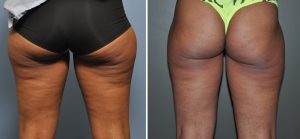Liposuction continues to be the most commonly performed of all body contouring plastic surgery procedures. The large surface areas that can be treated make for significant changes in the contours of one’s body. The marketing and promotion of liposuction across all types of media strongly suggest that it is a precise surgical procedure. Inferences are not subtle that surgical fat removal is able to achieve results that are comparable to ‘sculpting’ or the chiseling out of body parts.

The topography of the treated area is one important factor. Most of the body is not flat but rather a curved surface that has different thicknesses of fat as it curves around from area to another. This certainly makes it difficult to ensure evenness of fat removal, particularly when the aspiration is done with a straight cannula.
Liposuction surgery is almost always done with the patient in the supine or horizontal position. While this does not significantly affect some body areas, such positioning allows most fat collections to shift backward and become distorted as they lie or are pressed up against the operating table. The concept of ‘standing up’ liposuction is theoretically appealing but currently impractical.

To work around these limitations, there are some presurgical and intraoperative techniques that are used to get the best results possible. Marking the surgical sites immediately prior to surgery is critical. One must look at the planned treatment areas like a topographic map. The marks will indicate how far one has to go as the body areas shift and distort when one lies down. Marking the high and low spots also indicates how much time should be spent or tissue removed from one encircled area to another. Positioning the patient on the table can help tremendously with seeing the marked areas more ‘three-dimensionally’. For example, it is better to treat the lateral thighs or the flanks with the patient turned on one side. While this is more difficult for the surgical team, it is the best way to avoid seeing irregularities and missed areas of fat when the patient is seen standing weeks later in the office.
While new liposuction technologies appear fully capable of improving how well and even fat is removed, they are not magical devices. The use of laser liposuction (a.k.a. Smartlipo) is one example of how using a thermal approach (melting and liquefaction) may produce more consistent and even fat removal. The heat that it creates is promising for helping skin contraction, but it will not transform skin that is already damaged.
Liposuction is an improving plastic surgery technique but it is not yet an absolutely precise science. Its results are still somewhat of an art form. Patients should appreciate that perfect symmetry and evenness throughout a treated area can not be guaranteed and the desire for secondary improvement through touch-up procedures is not rare.
Dr. Barry Eppley
Indianapolis, Indiana


